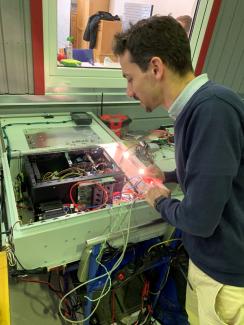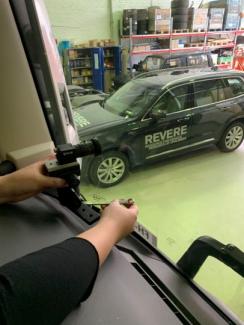SAFER's researchers pave the way for self-driving trucks through advanced data collection
Making a truck completely self-driving is not easy. But SAFER's researchers are working hard to make this possible by gathering data to better understand and “train” the automated systems of the future to drive safely. The purpose is to reduce traffic accidents, save lives while also operating vehicles more sustainably.
One of the difficulties for the researchers who develop the technology of the future is to ensure that the vehicle is operating safely in all possible conditions. When using machine learning (ML)-based approaches, the vehicle’s decision-making system needs to be trained to know how to do it right in each individual situation. And for that, large amount of information is needed from real traffic so that systems can be created based on real-world conditions. It is this information, which will then form the basis for building a safe and reliable software, which can make trucks self-driving in the future. The Vinnova FFI project “Autofreight” will now build a completely unique information bank by collecting data from real traffic on highway 40 between Gothenburg's harbor and the Viared industrial park outside Borås.
Christian Berger from the Department of Computer Science & Engineering, a shared department between Chalmers and GU, who also is a researcher within SAFER's collaboration platform and leads the project, says:
“We will collect huge amounts of highly qualitative data with our unique equipment. Every day for at least six months, the truck will run a couple of times a day between the Gothenburg harbor and Viared's Industrial Park, a stretch of about 75 kilometers one way”.
This means that an exact road section will be captured in many various driving and weather conditions; sun, rain, ice and darkness and with different types of vehicles around. Estimations indicate that over 100TB of data will be collected. The information processing platform is completely unique of its kind and will help researchers to take big steps forward in the development of reliable automated systems with this large scale dataset. One example is that the researchers, as a next step, can apply machine learning approaches to teach the vehicle to find other vehicles and road-signs in the traffic environment and to act appropriately.
“Today, researchers usually use already collected data; however, systematically collecting data from the same route on a daily basis under many various conditions that we now create within the project is enabling further research. The quality, such as the resolution of videos, can in many cases be deficient. In our project, we have advanced high resolution cameras and other high-performance equipment that ensure that the material we collect can pave the way for real products”, says Christian.
Advanced logging equipment
Several cameras are placed in the cabin of the truck that will drive the road section.
“The cameras are used to perceive the traffic environment in front of the truck, comparable to the driver's own eyes. We also continuously log the vehicle's position with an advanced GPS. Speed, gear, steering wheel position and similar parameters are also available, says Christian.
The videos will also be used by the researchers during the collection period, without the researchers having access to the truck. The information is uploaded to the cloud and can then be post-processed for continuous experimentation.
The vehicle lab Chalmers Revere, which is one of SAFER-linked research resources, has designed and developed the logging equipment and installed it in the vehicle.
Christian tells more:
- We call this part of the project “Voyager” as we’ll launch it on the road and then we cannot touch it. It will be very exciting to launch the project in the coming weeks.
The project adds value to the data factory
At Lindholmen Science Park, a national center has recently been opened, AI Innovation of Sweden, which is to promote the development and use of artificial intelligence in selected areas, where road safety is one. AI Innovation of Sweden provides resources, knowledge, data and capabilities that will accelerate applied AI research and innovation. The information collected within the project will be stored and used for various applications within the center's data factory.
The truck combination
The truck that will be used in the tests is called an “A-double”, which is approximately 30 meters long and consists of the combination Tractor + Trailer + Dolly + Trailer. The vehicle combination has a total weight of up to 80 tonnes.
The project will run until the beginning of 2020 and has a budget of about 50 million SEK. FFI accounts for 21 million SEK and the project partners stand for the rest. The project partners include SAFER Vehicle and Traffic Safety Centre at Chalmers, Volvo Technology, Combitech, City of Borås, GDL Transport, Volvo Bus, Speed Group, Ellos, Kerry Logistics and The Swedish Transport Administration (Trafikverket).
The project is also part of a larger logistics setup to explore the possibility of automated freight transports. When the trailer has reached the industrial park in Viared, a self-driving so called dolly will drag it to the current destination. In this way, the truck can remove a time-consuming and costly step. At the same time, the transport can be safer. Read more here https://www.saferresearch.com/news/self-driving-trailers-without-drivers-public-roads-soon-reality-new-safer-project .



